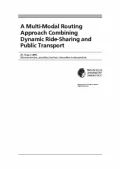-
Past ETC Papers

Browse, search and view papers from the past AET Conferences.
-
Members' Area

AET promotes networking and exchange of ideas, information and opportunities amongst members.
Conference Papers 2015
Frankfurt, Germany
ETC Conference Papers 2015
A Multi-Modal Routing Approach Combining Dynamic Ride-Sharing and Public Transport
Seminar
Day 2 (29 Sep 2015), Session 8, Removing the traditional distinction between public and private transport, 09:00 - 11:00
Status
Accepted, documents submitted
Submitted by / Abstract owner
Mohammad Hossein Keyhani
Authors
Sebastian Fahnenschreiber, Technische Universitaet Darmstadt, Felix Gündling, Technische Universitaet Darmstadt, Mohammad Hossein Keyhani, Technische Universitaet Darmstadt
Short abstract
We present a successful extension to our multi-modal routing system using dynamic ride-sharing as a supplement to public transport along the journey and an alternative for individual transport between first/last station and source/target location.
Abstract
Current and future mobility requirements demand intelligent solutions. Ride-sharing is gaining in importance, and yields benefits compared to costly, eco-unfriendly individual car rides. Dynamic ride-sharing makes better use of existing resources by bringing travelers with matching routes together. Participating drivers and passengers can be matched on-demand or in advance. This is done by calculating the detour required for the driver to give the respective potential passenger a lift. If the result matches certain criteria, both the driver and the potential passenger receive an offer and decide whether to accept or decline.
Our existing multi-modal routing system computes door-to-door connections by incorporating public and private transportation. It simultaneously optimizes the criteria travel duration, price, and number of train and mode changes. In this work, we present an approach to fulfill future individual traffic demands by proposing a journey information system, which adds dynamic ride-sharing to our routing system.
The motivation is that both these modes are complementary: On the one hand, public transport is quite sparse in some regions, but dynamic ride-sharing offers reach areas without public transport connectivity. On the other hand, the number of dynamic ride-sharing offers fitting to a query increases when allowing routes bringing the passenger to a station where he can continue his journey using public transport.
This way, dynamic ride-sharing as well as public transportation benefit from this combination: by offering dynamic ride-sharing to travelers using public transportation, the car utilization can be improved (reducing costs for the driver). Furthermore, the result quality of timetable information systems can be enhanced by additional optimal connections which use dynamic ride-sharing.
It is necessary to extend the internal representation of the public transportation timetable with dynamic ride-sharing offers. Here, there are two challenges: connecting public transport stations by dynamic ride-sharing connections, and connecting start and destination of a query to stations
by dynamic ride-sharing routes. The first challenge can be solved by deriving possible station-to-station connections from dynamic ride-sharing offers in a preprocessing step, and updating them when matches are agreed upon, offers are withdrawn, or new ones are available. The second challenge requires the selection of suitable ride-sharing offers that allow for a connection from the start location (given in the respective query) to the first station or from the last station to the destination location. Since these locations are different in every query, this step needs to be carried out on-the-fly.
We were able to successfully extend our system to combine both dynamic ride-sharing as well as public transport. This results in optimal connections and therefore alternative options for the passengers. Our computational study using real-world data provided by German dynamic ride-sharing provider flinc has shown that our approach successfully supports dynamic ride-sharing as an supplement to public transport between stations as well as as an additional way for the first and last part of the journeys within reasonable processing times.
Documents:

Association For
European Transport
Forester House
Doctors Lane
Henley-in-Arden
Warwickshire, UK
B95 5AW
+44 (0) 15 64 793552
VAT number: 710 1866 64
Conference Supporters & Endorsers




Legal Entity
The Association for European Transport is registered as an Association ('vereniging') with the Chamber of Commerce for Haaglanden in The Netherlands under company number 27170096.
Built on Zenario




